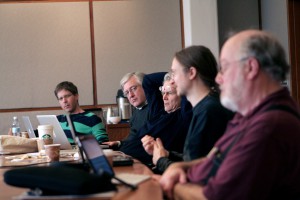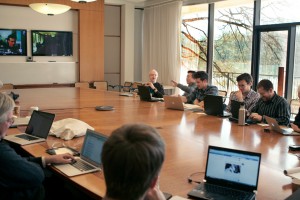ELSI Blog
43 The March MOL (Modeling Origins of Life) Workshop at IAS

Blog contributor Nicholas Guttenberg, second from right. Photo: Amy Ramsey, courtesy of IAS.
I've spent the last week in a sort of intellectual rush, having a chance to speak with researchers from sociology, history, chemistry, biology, computer science, and physics. I'm talking about the March 11th MOL Workshop at IAS (and the discussions which followed). Every day has been filled with discussions of models and ideas, from breakfast till the last call at dinner. But beyond even that, the really unique thing has been the energy brought to this meeting to not just discuss things but actually roll up our sleeves and get some work done; I can't think of another meeting in this field where groups of the participants sat down and wrote code and new models together right then and there.
On the first day of the meeting, we covered a number of topics from how one can actually measure the various phenomena of what is colloquially called 'life' to broad theories of life to how to build a collaborative community in which people participate and comment on each others' research in a fluid manner. Very quickly we ended up with a GitHub repository for our projects (both serious research codes and demos) and a number of examples of our various models - opensource and available for any researcher to use and modify. In the future, we've made plans for a forum and a weekly debate over Google Hangouts, a way to maintain this momentum we've generated.
Over the next few days we had time to discuss specific models in detail, something that the sort of relaxed format and small size of this workshop made possible. Getting a bunch of people from different disciplines on the same page about a model itself seems to be a very useful exercise - we each see something else in the model and get different things out of it. We discussed (among other ideas) the self-replicating cells arising from Tim Hutton's artificial chemistry, auto-catalysis and closure relationships in typed and untyped Lambda calculi, the GARD model.

Modeling Origins of Life (MOL) Workshop participants, on site at IAS and also via video telecom. Photo: Amy Ramsey, courtesy of IAS.
One contrast that came out of this mutual analysis was the difference between hand-crafted models and emergent or dirty models. With hand-crafted rules, it doesn't seem to be all that hard to build replicators even out of fairly physically constrained (e.g. stoichiometric, local interactions, etc) simple underlying elements. However, once these systems become dirty it can be difficult to sustain the behavior, and a similar system with random rules might not produce the behavior at all. What emerged was the idea of taking one or more of these handcrafted models and slowly allowing it to be randomized or have random rules in addition, to observe just how things break down and the way in which robustness is lost.
It is also clear even in the non-handcrafted models (GARD) that the dirtyness and entropic effects can play an important role. In GARD, much of the structure of the selective pressure comes not from inherent differences in replication rate but in the combinatorics of collections of objects of different types - the entropy of a mixed set is higher than the entropy of a homogeneous set, and also the equivalent mechanism to mutation has entropic biases as well that push the system out of a sort of evolutionary equilibrium into a state that doesn't obey competitive exclusion.
Hopefully as this collaboration continues and more people get involved, we can add a wider array of work to our collective understanding and start figuring out the right way to think about the difficult problems underlying modelling the origin of life.











